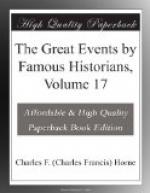Just one hundred years later upon the Muscovite throne, as nominal Czar, sat the weakling Feodor I; but behind the throne stood, as real Czar, hard, strong Boris Godunoff. Looking forward to Feodor’s death, Boris made ready to mount the throne; and he saw—what all other “Mayors of the Palace” climbing into the places of faineant kings have seen—that he must link to his fortunes the fortunes of some strong body in the nation; he broke, however, from the general rule among usurpers—bribing the church—and determined to bribe the nobility.
The greatest grief of the Muscovite nobles seemed to be that the peasants could escape from their oppression by the emigration allowed on St. George’s Day. Boris saw his opportunity: he cut off the privilege of St. George’s Day, and the peasant was fixed to the soil forever. No Russian law ever directly enslaved the peasantry, but, through this decree of Boris, the lord who owned the soil came to own the peasants, just as he owned its immovable boulders and ledges. To this the peasants submitted; but history has not been able to drown their sighs over this wrong; their proverbs and ballads make St. George’s Day representative of all ill-luck and disappointment.
A few years later Boris made another bid for oligarchic favor. He issued a rigorous fugitive-serf law, and even wrenched liberty from certain free peasants who had entered service for wages before his edicts. This completed the work, and Russia, which never had had the benefits of feudalism, had now fastened upon her feudalism’s worst curse, a serf caste, bound to the glebe.
The great good things done by Peter the world knows by heart. The world knows well how he tore his way out of the fetichism of his time; how, despite ignorance and unreason, he dragged his nation after him; how he dowered the nation with things and thoughts that transformed it from a petty Asiatic horde to a great European Power.
We were present a few years since when one of those lesser triumphs of his genius was first unfolded. It was in that room at the Hermitage—adjoining the Winter Palace—set apart for the relics of Peter. Our companions were two men noted as leaders in American industry—one famed as an inventor, the other famed as a champion of inventors’ rights.
Suddenly from the inventor, pulling over some old dust-covered machines in a corner, came loud cries of surprise. The cries were natural indeed. In that heap of rubbish he had found a lathe for turning irregular forms, and a screw-cutting engine once used by Peter himself: specimens of his unfinished work were still in them. They had lain there unheeded a hundred fifty years; their principle had died with Peter and his workmen; and not many years since, they were reinvented in America, and gave their inventors fame and fortune. At the late Paris Universal Exposition crowds flocked about an American lathe for copying statuary; and that lathe was, in principle, identical with this old, forgotten machine of Peter’s.




